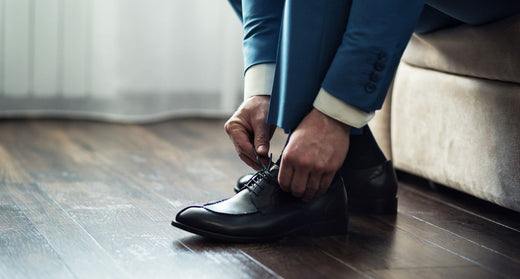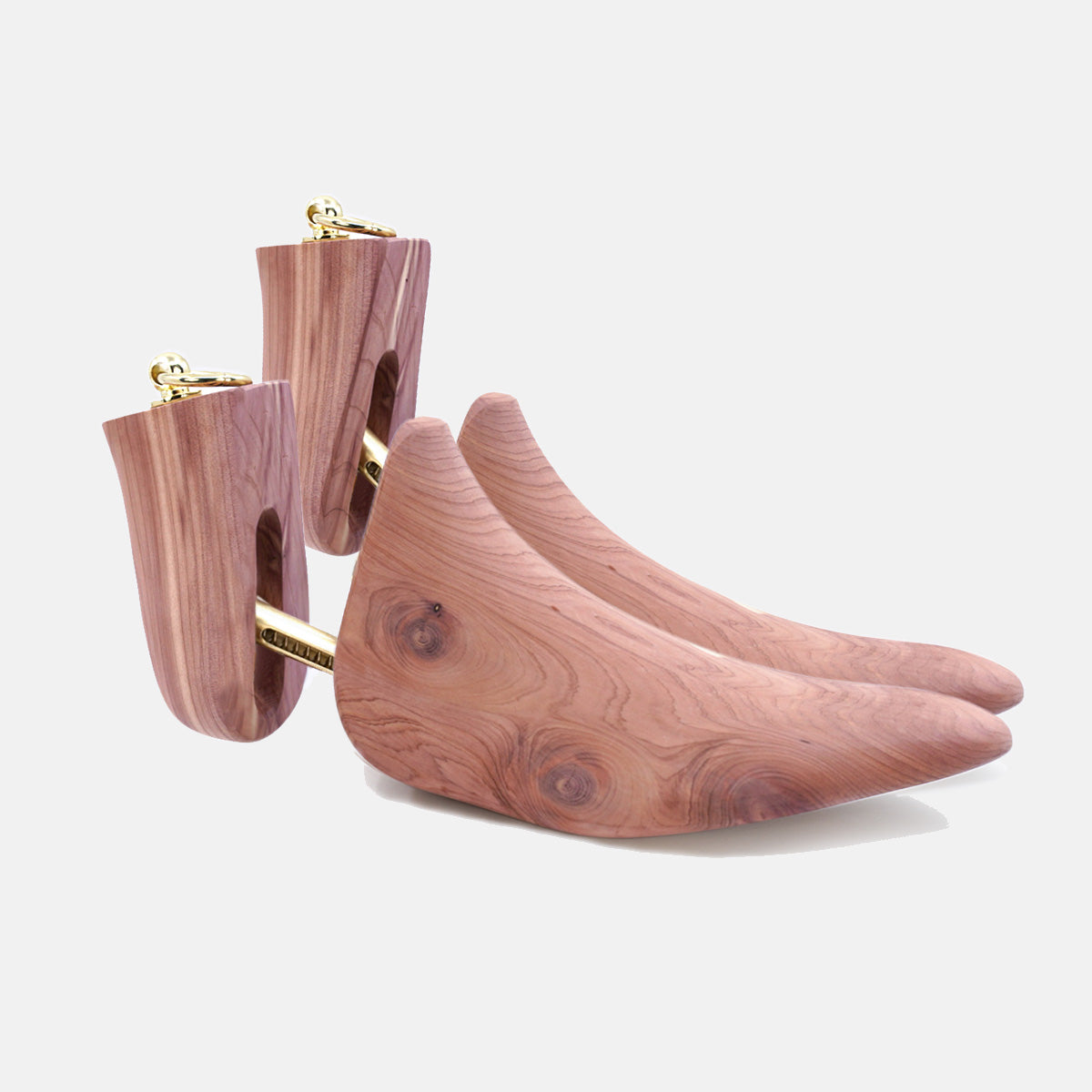Get 10% Off - Auto Applied At Checkout
Get 10% Off - Auto Applied At Checkout
Shoe Trees
shoe stretchers
Sets

Stretch Your Dollar: How to Make Tight Shoes Fit Comfortably
January 16, 2025 4 min read
Struggling with tight shoes isn’t just a small inconvenience; it can lead to wasted money, damaged shoes, and even foot pain. If you’ve ever regretted buying a pair that turned out to be too snug, you’re not alone. The good news is that you don’t have to toss them aside. This guide will teach you simple and effective ways to make tight shoes fit comfortably, featuring tools like shoe stretchers, shoe stretch spray, and other practical tips to save both your shoes and your wallet.
Why Tight Shoes Are a Common Problem
Causes of Tight Shoes
Tight shoes can arise for several reasons, and it’s not always about picking the wrong size. Here are the most common causes:
-
Sizing Variations: Different brands and regions have inconsistent sizing, making online shopping a gamble.
-
Material Changes: Leather and other natural materials can shrink or stiffen over time if not properly cared for.
-
Foot Adjustments: Feet change over time due to factors like age, weight, and even seasonal swelling.
Risks of Wearing Tight Shoes
Ignoring the discomfort of tight shoes can lead to more than just aching feet. Potential risks include:
-
Blisters, corns, and calluses from constant rubbing.
-
Long-term issues like bunions or joint pain.
-
Premature wear-and-tear on your shoes from excessive pressure.
Fortunately, with the right tools and techniques, you can comfortably break in your shoes without compromising their structure.
Solutions for Stretching Tight Shoes
How to Stretch Tight Shoes with Trimly’s Shoe Stretchers
A shoe stretcher is one of the most effective tools for solving tight shoe problems. At Trimly, we offer a range of stretchers tailored to different footwear needs:
-
Shoe Stretcher: Perfect for everyday shoes, these stretchers expand both the length and width to provide a better fit. Ideal for leather and similar materials.
-
Boot Stretcher: Designed specifically for boots, this stretcher adjusts tight ankle or calf areas, giving your boots the comfort you need.
-
High Heel Stretcher: If your high heels are pinching, this stretcher focuses on widening the toe box for improved comfort.
-
High Heel Boot Stretcher: Combines the functionality of a boot stretcher and a high heel stretcher, making it the go-to tool for high-heeled boots.
How to Use a Shoe Stretcher:
Depending on what type and brand you use, there might be slight variations in use, but the following can be universally applied in most cases:
-
Lightly spray the inside of your shoe with a shoe stretch spray.
- Insert and position the stretching plugs around problem areas.
-
Insert the stretcher and turn the handle until you feel resistance, then turn it three more times.
-
Ideally, leave the stretcher in place for 24-48 hours. If you're in a rush, try them on in 8 hours; and if they're still tight, turn the handle another full turn and try in another 8 hours.
-
Remove and test the fit; repeat as necessary.
The Power of Shoe Stretch Spray
Shoe Stretch Spray softens shoe materials, stretch them quicker and more evenly without causing damage. It’s safe for leather, suede, and even some synthetics. For best results, pair the spray with a stretcher. For the budget conscious, wear the shoes with thick socks immediately after spraying.
DIY Stretching Techniques
If you’re in a pinch, you can try these simple DIY methods:
-
Thick Socks and Heat: Wear thick socks, put on the tight shoes, and apply heat with a hairdryer to stretch the material gently. Use a shoe conditioner after completed to replace any loss of moisture in the leather.
-
Freezing Water Method: Fill plastic bags with water, place them inside the shoes, and freeze overnight. As the water expands, it stretches the shoe.
Warning: DIY methods can be risky, especially for delicate or high-value shoes. Use these techniques cautiously.
Tips for Preventing Tight Shoes
Choosing the Right Size
Prevention starts with selecting the correct size. Here’s how to avoid tight shoes:
-
Measure your feet regularly, as they can change over time.
-
Shop in the afternoon or evening when your feet are naturally more swollen.
-
Check size charts carefully, especially when buying from international brands.
- Find out what customers say about a particular shoes' sizing via online reviews or shoe forums.
Breaking Shoes in Comfortably
Breaking in new shoes doesn’t have to be painful. Here are some tips:
-
Wear new shoes around the house for short intervals before wearing them all day.
-
Use Trimly’s shoe trees to maintain the shape and gently stretch them.
-
Apply leather conditioner to soften areas that feel stiff.
Long-Term Shoe Care
Proper maintenance can prevent tightness and extend the lifespan of your shoes:
-
Condition and polish your leather shoes regularly to prevent drying and shrinking.
-
Use shoe trees to retain shape your feet have created.
-
Protect your shoes from water damage with waterproof sprays.
Frequently Asked Questions (FAQs)
Q: How does a shoe stretcher work? A: Shoe stretchers expand the length and/or width of shoes by applying consistent pressure, ensuring a better fit.
Q: Can I use shoe stretch spray on all materials? A: It depends on the spray's composition, so do read the instructions first. Trimly’s Shoe Stretch Spray is suitable for leather, suede, and some synthetic materials. Always test on a small area first.
Q: Are DIY stretching methods safe? A: While DIY methods can be effective, they’re riskier for expensive or delicate shoes. Professional tools like stretchers are safer and more reliable.
Q: How long does it take to stretch shoes with a stretcher? A: Results are typically noticeable after 8 hours but 24-48 hours is the sweet spot for a proper stretch. For particularly tight areas, you may need to repeat the process.
Q: How much stretch can I expect using a stretcher? A: A shoe stretcher can stretch a shoe up to half an inch.
Q: What’s the difference between a shoe stretcher and a shoe tree? A: Shoe stretchers are designed to expand the fit of shoes, while shoe trees maintain the shape and prevent creasing.
Conclusion
Tight shoes don’t have to be a source of frustration. With tools like Trimly’s Shoe Stretchers and Shoe Stretch Spray, along with smart care practices, you can ensure your shoes fit comfortably and last longer. Invest in the right solutions today and take the first step toward better-fitting, longer-lasting footwear.
Shop Trimly’s Shoe Stretchers Now and make tight shoes a thing of the past!
Subscribe
Sign up to get the latest on sales, new releases and more …













